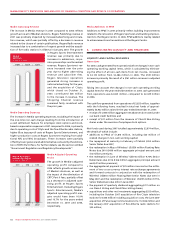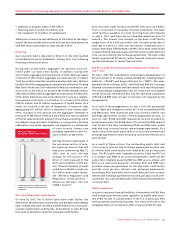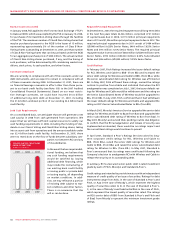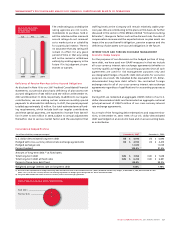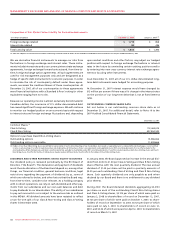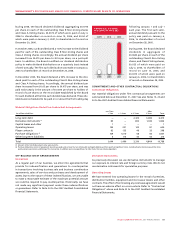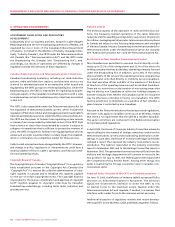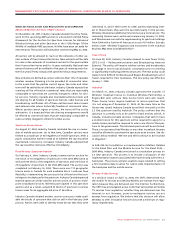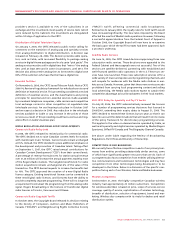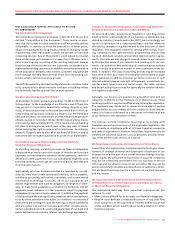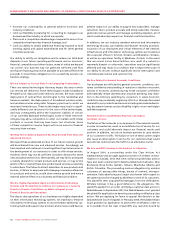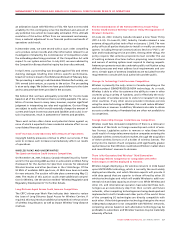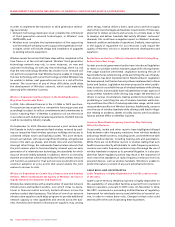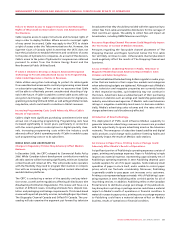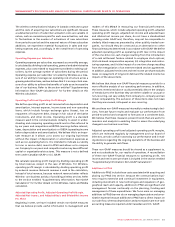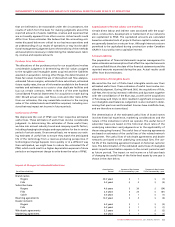Rogers 2007 Annual Report Download - page 57
Download and view the complete annual report
Please find page 57 of the 2007 Rogers annual report below. You can navigate through the pages in the report by either clicking on the pages listed below, or by using the keyword search tool below to find specific information within the annual report.
ROGERS COMMUNICATIONS INC. 2007 ANNUAL REPORT 53
MANAGEMENT’S DISCUSSION AND ANALYSIS OF FINANCIAL CONDITION AND RESULTS OF OPERATIONS
provider’s service is available to 75% of the subscribers in an
exchange and the incumbents meet quality of service tests (which
were reduced by the Cabinet), the incumbents are deregulated
within 120 days of application to the CRTC.
Distribution of Digital Television Signals
On January 7, 2005, the CRTC released a public notice calling for
comments on the transition of analog pay and specialty services
from analog distribution to digital distribution. A decision was
released on February 28, 2006. The decision provides cable opera-
tors, such as Cable, with increased flexibility to package analog
services in digital theme packages and in a la carte “pick packs”. The
analog services must be sold in digital tiers that “mirror” the analog
tiers until at least 2010 and in some circumstances, until 2013. The
decision also allows entire analog tiers to be moved to digital once
85% of the customers who have that tier have a digital box.
Essential Facilities
On November 9, 2006, the CRTC issued Telecom Public Notice CRTC
2006-14; Review of regulatory framework for wholesale services and
definition of essential service. This proceeding considered a revised
definition of essential service, and the classifications and pricing
principles for essential and non-essential services made available
by incumbent telephone companies, cable carriers and competitive
local exchange carriers to other competitors at regulated rates
(wholesale services). An oral hearing took place in October 2007
and we expect a decision in 2008. Any reduction in the wholesale
services available to Cable or any increase in the prices of those
services as a result of this proceeding could have a serious and neg-
ative effect on Cable’s business plan.
MEDIA REGULATION AND REGULATORY DEVELOPMENTS
Commercial Radio Policy 2006
In 2006, the CRTC released its revised policy for commercial radio.
The CRTC decided not to raise Canadian content levels for stations
with mainstream music formats. Cancon levels remain unchanged
at 35%. Instead, the CRTC decided to place additional emphasis on
the development and promotion of Canadian talent. Taking effect
on September 1, 2007, the CRTC raised annual contributions for
Canadian Content Development (“CCD”) from their current levels.
A percentage of revenue formula (0.5% for station annual revenue
over $1.25 million) will increase the annual payments made by most
of the Rogers Radio stations. The tangible benefits test for radio
station acquisitions remains unchanged at 6% of the value of the
transaction. The CRTC denied requests to increase the benefits test
to 10%. The CRTC approved the creation of a new Digital Radio
licence category. Existing transitional licences can be converted to
these new Digital radio licences, and licencees have the ability to
provide completely separate programming. There will no longer be
a requirement to simulcast the programming from the analog radio
signal. Rogers Broadcasting is the licencee of transitional digital
radio licences in Toronto, Vancouver and Ottawa.
Commercial Radio Copyright Tariffs
In October 2005, the Copyright Board released its decision relating
to the Society of Composers, Authors and Music Publishers of
Canada (“SOCAN”) and Neighbouring Rights Collective Society
(“NRCS”) tarif fs affecting commercial radio broadcasters.
Retroactive to January 2003, the royalty rates for both tariffs would
have increased significantly. The new rates imposed by the Board
affected the results of Media’s radio operations. However, following
a successful appeal decision from the Federal Court of Appeal in
October 2006, the Copyright Board will now have to re-examine
the basis upon which the tariff increases had been approved. Such
a process is underway.
Satellite Radio Services
On June 16, 2005, the CRTC issued decisions approving three new
subscription radio services. These decisions were appealed to the
Federal Cabinet and these appeals were not successful. Two of the
services are satellite-delivered, partnering with established and
well-financed satellite radio operators in the U.S. These two ser-
vices have now launched. These new subscription services offer a
wide variety of music and spoken word programming channels, and
will compete for audiences with the Media radio stations in mar-
kets across Canada. However, given that these new services are also
prohibited from carrying local programming content and selling
local advertising, the Media radio stations expect to sustain their
competitive advantage as local broadcasters in their local markets.
2007 CRTC Policy for Specialty and Pay TV Sector
On July 28, 2006, the CRTC administratively renewed the licences
for a number of programming services that were first licenced in
2000/2001, extending their expiry dates to August 31, 2009. The
CRTC decided to extend these licences by two years so that it can
take into account the determinations that will result from its review
of the policy framework for discretionary programming services.
This applies to the video-on-demand service operated by Cable, as
well as all specialty and digital services operated by Media (Rogers
Sportsnet, G4TechTV Canada and The Biography Channel Canada).
See above under Cable regarding the Review of Broadcasting
Regulations, Part II Fees and Diversity of Ownership.
COMPETITION IN OUR BUSINESSES
We currently face effective competition in each of our primary busi-
nesses from entities providing substantially similar services, some
of which have significantly greater resources than we do. Each of
our segments also faces competition from entities utilizing alterna-
tive communications and transmission technologies and may face
competition from other technologies being developed or to be
developed in the future. Below is a discussion of the specific com-
petition facing each of our Wireless, Cable and Media businesses.
Wireless Competition
At December 31, 2007, the highly-competitive Canadian wireless
industry had approximately 20 million subscribers. Competition
for wireless subscribers is based on price, scope of services, service
coverage, quality of service, sophistication of wireless technology,
breadth of distribution, selection of equipment, brand and mar-
keting. Wireless also competes with its rivals for dealers and retail
distribution outlets.



